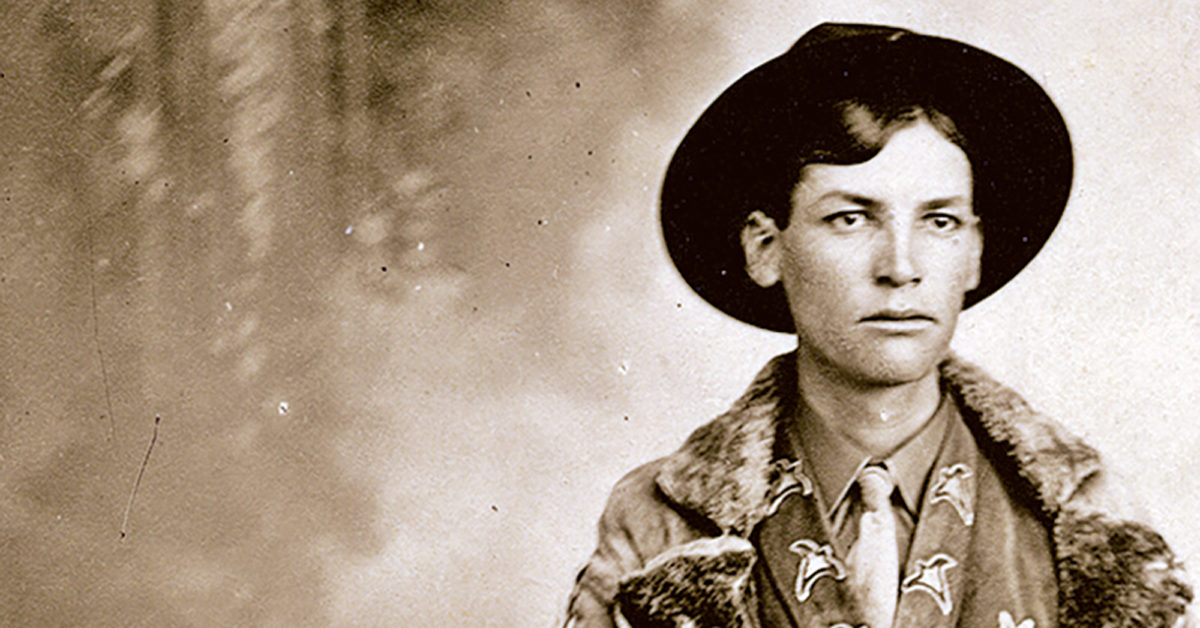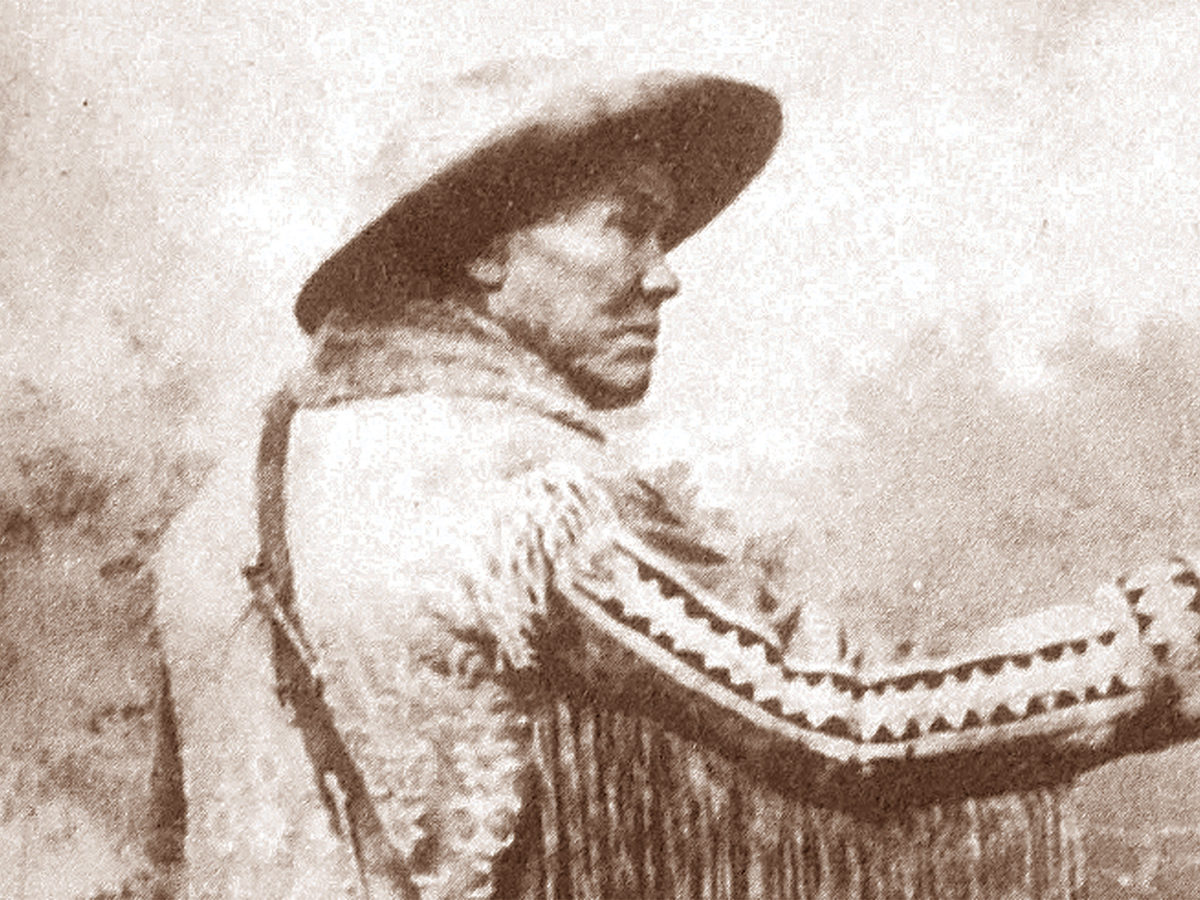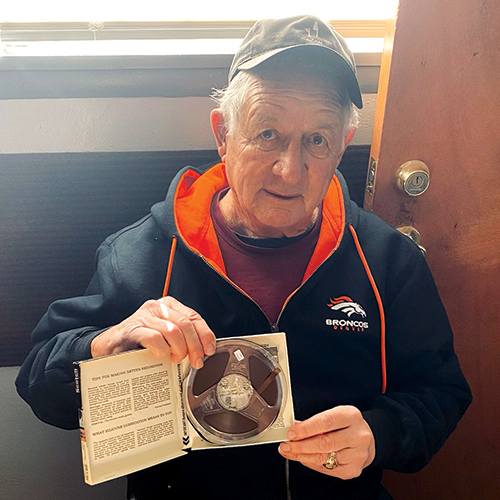
What follows is an account of frontier scout Tom Tobin (1823–1904) and his pursuit of the Espinosa family of killers, as told to and related by Christopher Kit Carson III, a grandson of both Tobin and legendary frontiersman Kit Carson (1809–68). The younger Carson (who was born on June 30, 1883, and died at age 91 on Nov. 28, 1974) shared this account in a Dec. 30, 1968, taped interview with Robert Leonetti, then a graduate student at Adams State College in Alamosa, Colo. The original transcript was never published. Daniel Sanchez-Leonetti, Robert’s brother, recently listened to the interview and cleaned up the manuscript for publication in Wild West. The editors have made only minor corrections to syntax and punctuation. Click here to listen to the original recorded interview.
On May 1, 1900, Tobin’s 77th birthday, he shared his exploits with then 16-year-old grandson Kit while the two were out looking for lost horses, and the latter never forgot his grandfather’s narrative. Tobin was justly heralded as the man who finally tracked down and killed Felipe Espinosa and nephew José in Colorado Territory in October 1863.
SO Many Stories About Tom Tobin
Kit Carson III: There have been a lot of stories written about Grandfather Tobin, and especially about him having killed them two desperadoes, the Espinosa brothers. There have been so many stories now that several times fellows came there to the ranch, located about 3 miles southwest of Fort Garland [Colo.]. Grandfather Tobin was a buddy of my other grandfather, Kit Carson, who was commander of Fort Garland at one time.…There used to be fellows that would come to interview him about the Espinosa deal, and when they would publish it, they published a whole lot of stuff that wasn’t true, things that he hadn’t told them at all. And he got so [angry], that was the last [they] came to interview him. He wouldn’t give them an interview, because they wouldn’t put down what he told them. They sent him a copy of their story, and [there] was lots of stuff in there that he hadn’t told them at all, so he quit interviews.
But what I got from him was right from him. It happened this way: My grandfather used to raise horses and some cattle, but his hobby was racehorses. He used to sell lots of these horses to buyers from New York and Eastern towns…and train them for polo ponies.…When we rounded them up in the fall, most of them would come in by themselves, but this time a bunch of mares and one stallion didn’t come in. So, the next spring [1900] my brother and I made two or three trips into the mountains looking for these horses…but we couldn’t find them, so grandfather and I went out to see if we could find them. And we were up Indian Creek, that little creek that comes up into the Sangre de Cristos just a few miles above Garland, but the head of it is between La Veta and Fort Garland. Well, we didn’t find them, and he was 83 years old [77] at the time. It was getting late in the evening, and he was getting pretty tired. We started back, and I happened to think when we were up on Indian Creek, and I says, “Grandpa, wasn’t it up in here that you killed the Espinosas?”
Recommended for you
And he said, “Yes.”
And I said: “Where about? Do you remember?”
He said: “That’s been a long time ago, and I don’t know as I could go to the exact spot anymore. Maybe I could.”
But his eyesight was failing him, and he was getting old, and it was getting late in the day.
Tobin had a reputation among the old fellas that he…could track a grasshopper through the sagebrush
THe Bloody espinosas
Robert Leonetti: What time of year was this when you were up at the creek with him?
Carson: That was sometime in May or June. But we stopped, and he showed me about where. He said: “Now Indian Creek goes up here. Up here a little ways there is another creek come into Indian Creek from the north.…[It] was about probably 2 miles north of the junction of this little creek and Indian Creek.”
Now, this is the way it had happened. These two outlaws of the Espinosa brothers [Felipe and Vivián] had come up from New Mexico [Territory], and they [had] been terrorizing this part of the country from New Mexico clear into the South Park here in Colorado. It was said that they had killed about 23 [Felipe claimed 32] men on the rampage and had a grudge against the Americans. There had [been] so many different stories about it that nobody seemed to know just what it was, but it seems like it stemmed from the Mexican War. [They] traveled through the country here, and any white man that they [saw], they’d kill. Posses had been after them for eight years [actually two].…[Scouts] and old soldiers from Fort Garland been after them, but couldn’t get them. They never come out into the open. They just traveled in the mountains from north to south of the Sangre de Cristo Range. The state had ordered a reward of some say $1,500 and some say $2,500 for the capture of the Espinosas.
So, it happened that at this time these Espinosa brothers had killed a man [Leander Philbrook actually escaped their ambush unharmed and fled to Fort Garland] between La Veta and Fort Garland.…He was coming over into the valley. He was married to a Spanish woman [Philbrook’s passenger, Dolores “Lola” Sánchez of Trinidad, was not his wife]. He was driving a buckboard [buggy] with two mules, and just as he came over the top of Indian Creek pass [Sangre de Cristo Pass] into the valley, one of the mules was shot from ambush. Of course, the fella couldn’t get any further. He had to stop.…They kept the woman captive for three or four days [actually a matter of hours]. During the day they would go away while she was held captive, but they [would] tie her to a tree until they got back. One day she got loose, and she started down the road toward Fort Garland.…She met a bunch of soldiers on patrol, and they brought her down to Fort Garland. She told the commander at the fort [Lt. Col. Samuel F. Tappan] her story and gave the location…as well as she could.
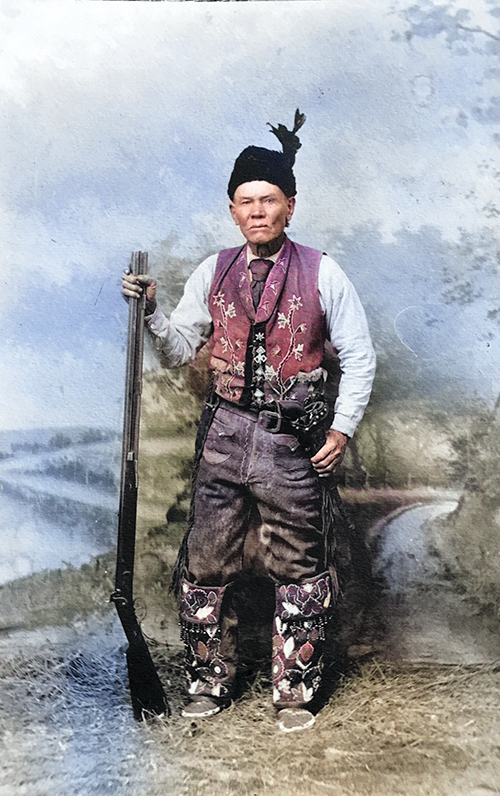
Well, this commander, he didn’t know what to do, because he’d been trying to get at these fellas a long time, so he thought of Tom Tobin. He sent after him at the ranch and [said], “Tom, I wish you’d go and see if you can get these fellas. We know they’re in this part of the country, and I think that you’re the man that can track ’em down.”…Tobin had a reputation among the old fellas that he…could track a grasshopper through the sagebrush.
He didn’t want to go at that time. He said he couldn’t leave, because they were expecting a baby at the house…and he thought he better not go. But the commander insisted…so he decided to go. He went back to the ranch to change horses, and the commander at the fort had said that he would give him all the men and equipment that he wanted.…But grandfather said: “What would I do with a bunch of soldiers? I couldn’t handle them. Besides, they’ve been after these fellows for a long time and haven’t caught them, and they couldn’t get ’em this time either.” So, he went to the ranch…and a Spanish family working for them at the ranch had a boy [Juan Montoya] about 15 years old, and he took this boy with him.
The next morning they started out early, and they came to the place where the buckboard [buggy] was. They took the mule that they didn’t kill with them, these Espinosas. So, Grandfather started to track ’em, and their tracks were headed south. Well, he followed the tracks south for a little ways [and] figured that they had backtracked and went north instead. So, he went back to where he had started.…Well, they only went about a mile, maybe 2 miles, north, and being he was a tracker, he figured that he wasn’t very far behind. [When] the tracks got pretty hot, he left the boy with the two horses. He told the boy: “Now, you see the shadow of this tree across the gulch, there across the creek? When that shadow points to that point of rocks on the other side…and I’m not back, you take the horses and go back to the fort, because I won’t be back.”
Tom TObin Finds the Bloody Espinosas
So, he went, and the further he went, the hotter it got. So, pretty soon he located ’em. They had a little fire going, a small fire.…It was only one brother that was left then. Before that time [the] Espinosa brothers had held up a stagecoach up in South Park, and some fella had killed one of the Espinosa brothers [Vivián was killed in a shootout with a citizens’ posse]. He killed him, so the other one that was left [Felipe] went down to New Mexico and got his nephew [José], a boy about 19 or 20 years old [actually 14], and he got to be worse than his uncle.
So, Grandfather had a muzzleloading rifle—you know, a Hawken rifle…that you used to have to pour the powder in and then ram the bullet in and put a cap on the tube before you could shoot. So, he put two bullets in his mouth, and he snuck up behind a fallen tree. He had to get close because them rifles didn’t carry as far as our modern rifles do. And one shot, and if you missed, you was a goner. So, he snuck behind this log, and the uncle, the old man [Felipe], was cooking some meat on this campfire. [They] killed some animal [a stolen ox], and they had some of the meat hung up on the willows to dry. The young fellow [José] was off a little ways, taking care of the horses, something. And Grandfather got within range, and he said this old fella was like an animal. He could sense danger. He hadn’t seen grandfather or heard him, but Grandfather said he’d stoop over to stir his meat. But he’d straighten up right quick and always reach for his revolver, but he didn’t take it out of his scabbard at all. Then he’d go ahead with his meal. Grandfather didn’t want to shoot him until he got the two of them together.
Pretty soon the young fella came, and he started to unpack some sacks that they had, and they were talking, but Grandfather was too far to hear just what they were saying. But he could have understood ’em, because he [could] talk Spanish.…So he got ready, and the old man stooped over again to take care of his meat, and the young fella dumped something out of his sack. And Grandfather took a crack, and the old man pitched over into the fire, but he wasn’t dead. He rolled out of the fire. It only singed his whiskers.…Grandfather said he had never seen a more horrible looking thing than that old man. Probably hadn’t had a bath in years or shaved or anything. He was dirty, and his fingernails were so long that they curled over his fingers. But anyhow, he cracked down on the old man.…The young fella started to run, and Grandfather called to him in Spanish and told him to stop, and he stopped long enough to fire his revolver at Grandfather, but he missed, and he started to run again. Just as he got to the edge of the timber, Grandfather cracked down on him, and he went down. So, Grandfather walked over to the fire. The old man was laying on his back. He wasn’t dead, but he had his revolver in his hand, and he waved [it] over his face once or twice and said, “Damn the Americans.” He didn’t know who shot him. He hadn’t seen anybody. And then Grandfather went over to the young one, the nephew, and he was dead. He broke his back.…
GET HISTORY’S GREATEST TALES—RIGHT IN YOUR INBOX
Subscribe to our HistoryNet Now! newsletter for the best of the past, delivered every Monday and Thursday.
Verifiable proof
Grandfather came back to the camp and wondered what he should do. He couldn’t take the bodies to Fort Garland. He had to take some evidence, and he only had the two horses, and it was a long ways [to the fort]. So, he took his hunting knife and cut off the old man’s head and then went and cut [off] the young one’s head…and put them in a sack that the young one had emptied [and] walked over to where the horses were. And when he got there, the horses were there, but the boy…had taken off afoot and had hidden in some rocks. But he finally found him and tied the heads on behind the saddle.
the commander says, ‘Tom did you have any luck?’ and Grandfather went behind the door and picked up a sack and dumped the heads out. He said some of the women fainted…[and] men turned green
[Grandfather] came to the fort…and there was an orderly in the commandant’s office, but all the officers [and their wives] had gone down the road toward San Luis for a [ride].…So he sent the orderly after them. And they all came in, and the commander says, “Tom did you have any luck?” and Grandfather went behind the door and picked up a sack and dumped the heads out. He said some of the women fainted…[and] men turned green.…The commander says to the orderly, “You take these things out of here and bury ’em someplace.”
So Grandfather went home. And see, when he went after these fellas, he didn’t know that there’d been a reward offered by the state [territory]. And the reason he went was like all these old-timers done. He done it for humanity sake and to protect mankind that these fellas were killing all over the valley, all over the place.…When [he] got to the home, the baby he was expecting was already there.…
After he learned there was a reward out for ’em, he didn’t claim it until a few years later. He put in a claim to the state, and the Legislature hopped back and forth, and they didn’t have no funds for [those] things.…Eventually they paid him [$500 from Territorial Governor Edward Moody McCook, followed 30 years later by $1,000 from Governor Davis Hanson Waite].
Leonetti: And it was supposed to be a reward of $1,500 to $2,500?
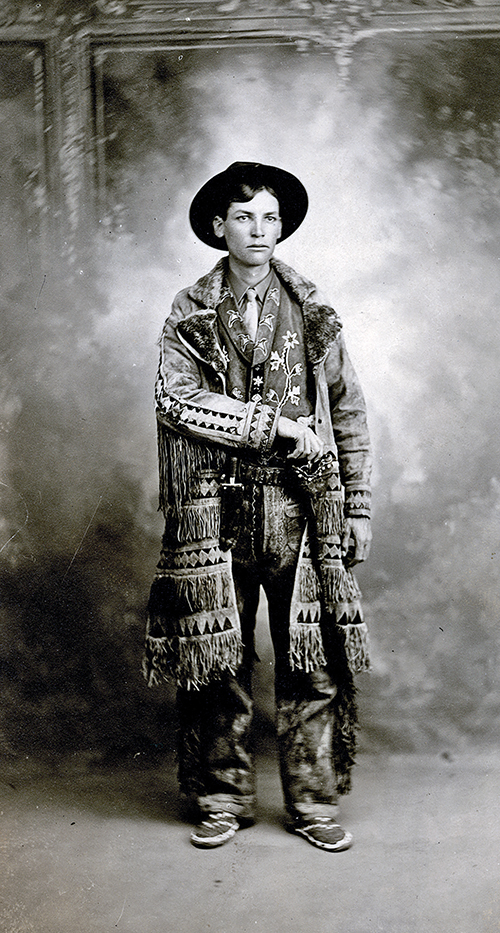
Carson: Fifteen hundred or $2,500. Some said $1,500, others said $2,500.…Some say that he got $1,500 dollars, but, you know, Grandfather couldn’t read or write. He could write his name, but that was all. Now, if they ever paid $1,500 or $2,500 dollars, whoever does his correspondence for the state probably got the balance of it.…
Making History
Carson: One time I was in Colorado Springs, and I met with the historical society of the Pikes Peak region, and they were talking about Kit Carson—my other grandfather. And eventually someone brought up this Espinosa deal, and they started to ask me about names and dates. I said, “My gosh, I have such a poor memory that I don’t remember dates or names either.”
Well one of them said, “Do you remember what time of year it was when your grandfather got these Espinosas?”
And I said, “Yeah, in October.”
And he says: “What year? Do you remember that?”
“Yeah, 1863.”
He says, “Well, I thought you didn’t remember dates?”
“Well, I have reason for remembering that date.”
And he says, “Why?”
“Well, when he got home, that baby born that day…later became my mother [María Pascualita Tobin]. And so I remember that date of her birth and the year. So, it was October 1863.”
Gory Details
Leonetti: I wanted to ask you about the old man [Felipe] Espinosa. You said he [your grandfather] shot him first, and he rolled over the fire.…Did he just die there?
Carson: No, Grandfather seen him wave the revolver past his face, and then [he] passed away. Grandfather didn’t have to shoot him again, because he seen he was too far gone to do any damage.…He went to see about the boy. [When] he got back…the old man was dead.
Leonetti: And you said they had great big, long fingernails. I could just imagine those dirty long fingernails and big beards.
Carson: Long fingernails, long black beard, and fire had singed part of his [Felipe’s] beard away, so he was an awful looking sight.
Leonetti: Were they in buckskins?
Carson: I suppose they were in buckskins. Now, lots of people say in stories that [have] been written that…some museums has souvenirs.…Some say they kept a diary and the names of the fellas that they killed. Now, tell me, how would these guys keep a diary when they were illiterate? [The brothers were actually found with letters and a diary written in fluent Spanish]. They couldn’t write, they couldn’t read, and they didn’t know who they [had] killed. Now, they weren’t going to ask a man what his name was and then kill him. They killed all these fellas from ambush.
Leonetti: Do you think they, according to your grandpa, killed people here because they had such a dislike for Americans?
Carson: That’s right. Because it wasn’t for robbery.…[The] men killed, most of them…were timbermen, prospectors or things like that. They [Felipe, Vivián and José] couldn’t think that they had any money with them. Besides, what good would money do the Espinosas? They didn’t go to town.…They would swoop down on some village…change horses, take what horses these fellas had and provisions. And of course the Spanish people—most of them, not all—they were in sympathy with the Espinosa brothers, naturally. Lot[s] of them around [Fort] Garland [in] later years, they had a dislike for my grandfather…on account of [going after the Espinosas.]
Back at Fort Garland
Leonetti: Do you remember who the commander was at the time at the fort?
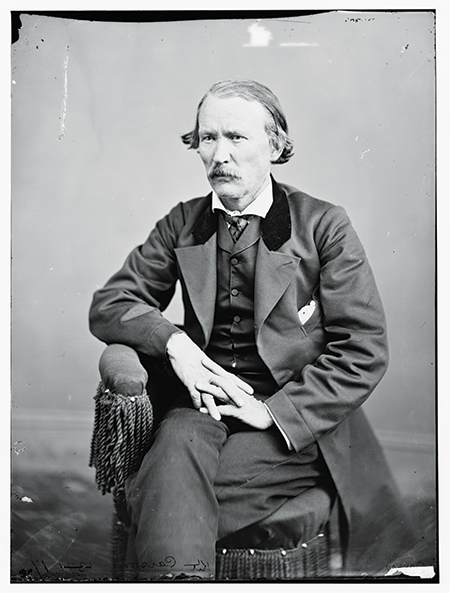
Carson: No, I don’t remember.…I was born in the same house where Grandfather [Carson] had his headquarters as commandant of Fort Garland. I was born in that same house.
Leonetti: During the time he was commandant?
Carson: No, Grandfather Carson was commander at Fort Garland in 1852 [actually 1866–67], and I wasn’t born until 1883. But I was born in the same house [in which] he had his headquarters, which is still there.
Leonetti: How was your father related to the original Kit Carson?
Carson: My father was the original Kit Carson’s eldest son. His name was William.…William married Tom Tobin’s youngest daughter…the one that was born when Grandfather killed the Espinosas.
Leonetti: And that was your mother?
Carson: My mother. WW
Author Daniel Sanchez-Leonetti, whose hometown is Trinidad, Colo., found the 5-inch reel audiotape of the interview brother Robert recorded in 1968 with Kit Carson III in Robert’s shed, where it had lain undisturbed for 52 years.

